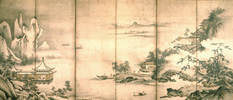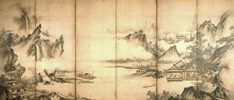| Pico Iyer | |
|
Pico Iyer is both a fiction and nonfiction writer. He was born in Oxford, England, and educated at Eton, Oxford, and Harvard. His essays, reviews, and other writings have been appearing in Time magazine since 1982. For Time, he has written on such varied subjects as former Philippine President Cory Aquino and the Olympics. Iyer has also contributed articles to Conde Nast Traveler, Civilization, the New York Review of Books, Sports Illustrated, and the Times of London. His books include Video Night in Kathmandu, The Lady and the Monk, and a novel, Cuba and the Night. They have been translated into many languages and published in Europe, Asia, South America, and North America. His latest work is The Global Soul. Selected Objects |

Madhu Madhavi Ragini
India, Madhya Pradesh, Malwa region
about 1660-1680
Opaque watercolor and ink on paper
9 x 6 5/8 in. (22.9 x 16.8 cm); 1979.57
This piece does not oblige the prejudices of the moment, perhaps (a man reclining while a woman hastens towards him); and yet what I see in it most deeply, and most elegantly, is a vision of grace and leisure-of space, you could say-inside an exquisite pavilion whose very orderliness confers on us a sense of calm. The woman is hurrying through the rain to her beloved, I read, but when I look at it I see a man-a prince, perhaps-waiting for a woman to dance for him; and I see the woman nonetheless as the one with the power, leading his eyes (and ours) up towards the two birds who fly neither ahead of one another, nor behind.
The East has always
seemed to me the great spiritual home of the miniature- a moment distilled
into something so compressed that it explodes in the heart of someone
who sees it on the far side of the world. In this beautiful example I
see a dance of motion and stillness that lifts us up from the brownish
earth towards the bluish heavens.

Nepal
Early Malla period, 13th century
Gilt copper alloy with inlays of semiprecious stones
H. 18 3/4 in. (47.6 cm); 1979.49
The gender of the figure hardly seems to matter; whether brother or mother or beloved, (s)he brings us something of the graces of all three. One hand says to me, "Be calm" (or "Stop your thinking and your talking, put away all agitation"); the other, so loosely turned towards the ground, says, "Sit here. Whatever happens, you need not get stirred up: I'm here. You're here. Be at peace."

China, Jiangxi Province
Ming period, mid- to late 15th century (probably Chenghua era, 1465-1487)
Porcelain with glaze (Jingdezhan ware)
H. 1 3/8 in. (3.5 cm), D. 6 1/2 in. (16.5 cm); 1979.177
As anyone who has seen the classic films of Chen Kaige and Zhang Yimou (Yellow Earth, say, and Ju Dou) knows well, China still has the gift of communicating powerfully through colors (in Anchee Min's confessional account of the Cultural Revolution, red speaks for blood and passion, as well as for the ideology she was at once upholding and defying). In this particular piece the red, or rustish, color suggests to me the earth, and, apparently, the color of sacrifice, and yet also (with that slim white rim) asks what price sacrifice entails.
Looking at this piece,
I think of the circle that turns at the heart of Eastern thinking, roughly
inscribed by Zen masters and conveying energy and harmony together. I
think of time as something that moves around instead of forward. And I
think of all the ancient scrolls and poems so simple that they go right
through you. So simple, in fact, that they touch on mystery.

Bodhisattva Kshitigarbha (Jizo Bosatu)
Japan
Kamakura period, 1223-1226
Cypress wood with cut gold leaf and traces of pigment; Staff with metal attachments
H. 22 1/4 in. (57.8 cm); 1979.202a-e
I see this figure, so I imagine, every time I walk across Shijo Bridge, above the Kamo River, in Kyoto. Around him are pachinko parlors, 14-story hotels, a tiny McDonald's that once claimed to own the world record for most hamburgers sold in one day. Kids with yellow hair, and muscle cars, and beeping cell phones. He stands in the middle of the congested city in just these sandals, head bowed, as if he were aspiring to be nothing more than any monk, or every monk.
Often, a hat obscures
his face, as if to complete the annulment of personality; just as often,
you can see nothing as you walk past except his extended bowl. Always
he seems about to wander off into the mist. This piece moves me because
it speaks for everything that doesn't change in Japan-or anywhere-in the
midst of all its transformations. It tells me that what doesn't change
is what sustains us. And, in some ways, it explains how Japan keeps its
soul alive while it changes with each season: Jizo stands in the middle
of the busy modern city, and his presence sounds inside us like a bell.

The Four Seasons
Japan
Muromachi period, mid- to late 16th century
Pair of six-panel folding screens; ink and light color on paper
Each 61 x 142 1/8 in. (154.9 x 361.0 cm); 1979.216.1-2
If someone were to ask me why I choose to live in Asia, I would point her to these screens: the absences at their center, the mist, the indefinable sense of sadness at their heart. Looking closely, I see that the landscapes are richly populated; and yet all the figures are tiny, inconsequential almost, in the context of the larger pattern, and at their center is an emptiness-a cloud, a mystery-that I can still believe to be the heart of East Asian cultures today.
In Oriental art, I am reminded, the subject of a painting may be what is left out; and people leave themselves out, often, so that a feeling-as here of wistfulness, or melancholy-becomes much stronger than the press of personality. The individual recedes before the passing of the seasons, and in these paintings I feel I can see an affirmation of the moment in the face of (and not smudged by) the fact that moments always pass. A joyful participation, as the Buddhists say, in a world of sorrows.
When first I went to live in Japan, in 1987, I found that no religion was observed more ceremoniously, or more selflessly, than the seasons; in life as on the canvas, people disappear inside a scene as if not to smudge it with themselves. I look here at the figures turning around a corner, I see a lonely spire poking through the mist, I imagine a bird's distant cry and I feel as if something is calling to me from the next valley over but one.
